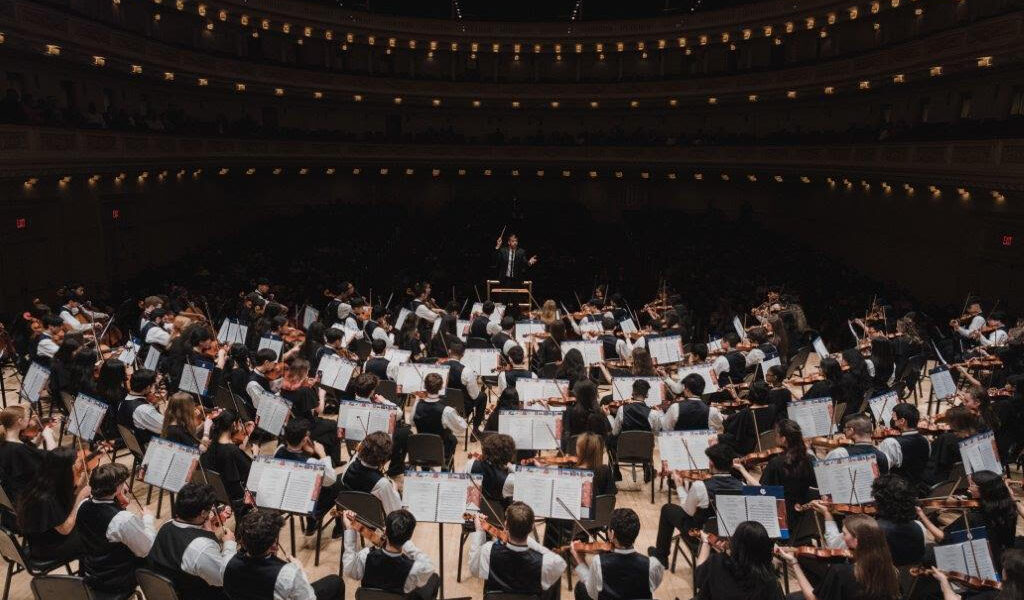Distinguished Concerts International New York (DCINY) presents Windsongs in Review
Santiago High School Choirs (Corona, CA)
Santiago High School Treble Ensemble; Santiago High School Combined Women’s Choir; Santiago High School Madrigals
Karen Garrett, Director; Alexis Ohmar, Piano
East Brunswick High School Orchestra (NJ)
Arvin Gopal, Director
Stern Auditorium at Carnegie Hall, New York, NY
March 18, 2023
I should be, and in fact I am, a cheerleader for all things involving young people and music education and participation, and all the benefits they bring. Therefore, I may appear somewhat Scrooge-like in some of my less flattering comments below, but I wish to take nothing away from the hard work and enthusiasm these high school youth and their leaders put into their programs. Two disparate types of music (choral, string orchestra) from opposite ends of the country (between Riverside and Anaheim CA, and, just a few miles down the NJ turnpike) split the bill on Saturday evening.
Was it a sort of metaphorical Saint Patrick’s hangover that caused such a low (though highly vocal) turnout? Or was it the constant clomp-clomp of the Carnegie ushers swooping down the aisles to chide the omnipresent photo and video takers during the performance that detracted from my ability to surrender to the performance fully?
First on the program were the various combinations of choral activity from Santiago High School in California, ably led by Karen Garrett and their pianist, the sometimes too firm Alexis Ohmar. The Treble Ensemble, a group of twenty-six young women, shone best in the Hassler motet Cantate Domino. Elsewhere, in folksong and Spanish contemporary pieces, their sound and diction were diffuse, I believe mainly because of their odd positioning on the risers. With so few singers placed so far from each other, it is much more difficult to produce one cohesive ensemble sound. Perhaps they wished to appear more sizeable than they are, but this issue also affected the other two Santiago groups.
The Combined Women’s Choir was at its finest in Beverly A. Patton’s Exaudi Laudate!, though it lost a dimension without the TB portions of its original SATB choral layout.
Finally, the Madrigals (thirty-five singers, with the addition of male voices) was the most successful of the three groups. They sang a wide range of material, from Viadana to spiritual, with focus, diction, and color, even in the sometimes overwrought Lamentations of Jeremiah by Z. Randall Stroope. After all, isn’t Jeremiah himself somewhat overwrought?
After intermission and the customary massive stage re-orientation, the gigantic East Brunswick High School Orchestra took the stage. I am using their billing, but I must state that this was a group of 170 (!) string players only (violin 1 and 2, viola, cello, double bass). Why they don’t call themselves a string orchestra is beyond me. They were led in style by Arvin Gopal, an experienced, formally trained violist (inner voices!), in music by Sibelius, Warlock, Ippolitov-Ivanov, Mozart, and others.
Sibelius’ Andante festivo opened their half of the program, and it must have been the best rehearsed work, or perhaps something about its composition makes it more forgiving, for the massed string sound was luscious and very Sibelius-appropriate, in his own amplification from string quartet to full string orchestra, despite the lack of triumphal thwack by the timpani.
Unfortunately, the same cannot be said for the other selections. An orchestra of one hundred seventy musicians is larger than any currently functioning professional symphony orchestra in the world, including ALL the sections (woodwind, brass, percussion). Here, the valiant East Brunswick youth lumbered their way through three sections of Warlock’s delightful Renaissance pastiche Capriol Suite, which lacked the needed delicacy and transparency. Hofeldt’s The Journey and Silva’s Forest Incantations didn’t make a strong impression on this listener.
However, they did achieve success in Ippolotov-Ivanov’s Procession of the Sardar from Caucasian Sketches. This impression was immediately undone by the final offering, the Finale from Mozart’s Symphony No. 41 in C major, K. 551, known as the “Jupiter.” This work is for full (but SMALL) orchestra, and it was played at half the requisite tempo, with poor intonation and realization of the miraculous polyphony therein, based on its initial theme, a Gregorian chant fragment known as Confiteor (I confess to almighty God… that I have sinned).
I won’t go as far as to say that they “sinned,” but my advice to East Brunswick, which obviously has the means to fund such a huge string orchestra, is to invest equally in woodwind, brass, and percussion programs, and conduct rigorous auditions to create an ensemble of manageable size.
None of my carping can reduce the obvious pride and happiness shown by the parents of the young people involved, whose tumultuous ovations had nothing to do with any fussy reservations on the part of this, or any, critic.

